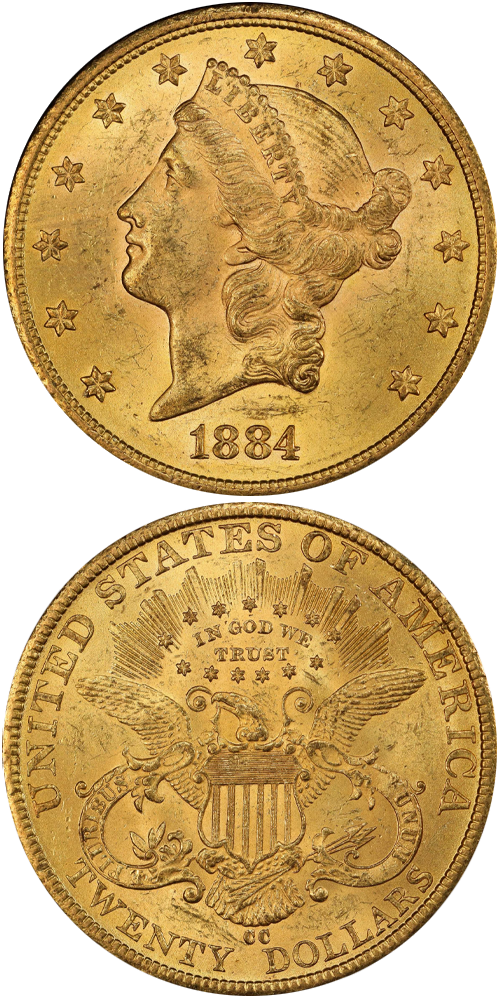1884-CC Liberty Head Double Eagle
Jeff Ambio: The only known obverse die of the 1884-CC double eagle exhibits a relatively small, compact date logotype that is set slightly low in the field. The CC mintmark is tall, compact and placed somewhat high in the field. The first C is centered over the space between the words TWENTY and DOLLARS and the second C is centered over the serif of the letter D in DOLLARS.
Rusty Goe: As 1884 began, everyone in the country knew that much was at stake in this presidential election year and Nevadans kept a close watch on all that transpired in the political arena. The state's overwhelmingly Republican constituency knew the implications of having a Democratic president for the first time since before Lincoln had granted it statehood in 1864. Senator John P. Jones, who was seeking his own reelection in 1884, told a crowd at a rally in Carson City in October that, if Republican candidate James G. Blaine became the president he would order his Treasury secretary to coin the maximum amount of silver dollars and would "place silver on a par with gold." In contrast, if Cleveland won, "he would not allow any increase of coinage," and would probably push for the discontinuance of the silver dollar's production altogether. Furthermore, Jones told the crowd that the Democratic Party would cater to the whims of Wall Street and big banks, both of which preferred gold to silver.
Reverberations of the political melee shook the Carson City Mint. In this crucial election year, Superintendent James Crawford had to take a distressful action and fire his friend of 30 years, William S. Byrne, (the mint's cashier ever since Crawford had assumed office in 1874), because Byrne was a Democrat.
The residents in Carson City also faced the danger of losing their mint if Cleveland won. Already, in January 1884, they had dealt with the news that Senator Hill from Colorado had proposed to Congress to move the minting rights from Nevada to Denver.
During this stormy election year, the Carson Mint's army of about 100 or so workers kept busy making silver dollars, and as many gold coins as deposits would allow. The Carson City Mint's 1884 double eagle mintage of 81,139, divided almost equally in terms of production for both halves of the year, landed in fourth place for the highest output of double eagles in Carson City up until that time.
The survival rate for 1884-CC $20 gold pieces is about the same for other dates in the series: three to three and a half percent. Because of the higher original mintage figure, and because so many examples of this date were shipped to foreign countries before being repatriated in the 20th century, Mint State specimens are relatively plentiful.
Q. David Bowers: From the 1884-CC double eagle mintage Rusty Goe estimates 2,600 to 3,000 survive, with 340 to 390 in Mint State. My estimates are significantly less.
This coinage circulated extensively in the West and also was used in the export trade, the latter usually having had some light wear before being sent to foreign destinations. Today the 1884-CC is rare enough to be numismatically enticing, common enough (in the context of Carson City coinage) to be numismatically available. VF, EF, and AU coins abound. Years ago, VF and EF were dominant. In recent decades the supply has been augmented by many nice EF and AU pieces from overseas sources -- to reiterate a familiar scenario. Higher level coins are mostly in the MS-60 to 62 range, but a few finer exist, the presently-offered example among them. Most are imports and are extensively bag marked.
The example to the left was sold by Stack's Bowers Galleries in the Fairmont Collection, Hendricks Set, where it realized $120,000.






